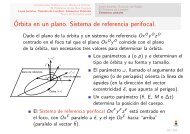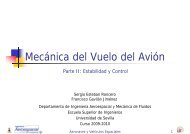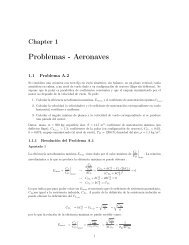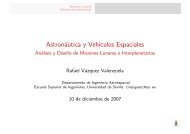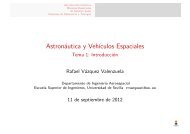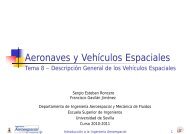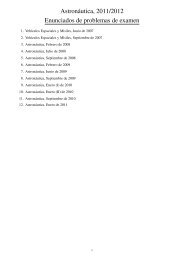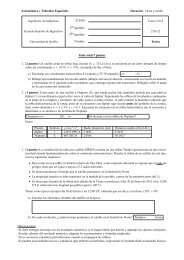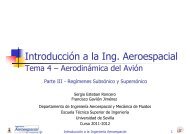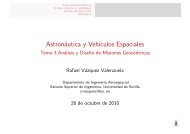Geodesia. Cartografía. Sistemas de referencia. Tiempos.
Geodesia. Cartografía. Sistemas de referencia. Tiempos.
Geodesia. Cartografía. Sistemas de referencia. Tiempos.
Create successful ePaper yourself
Turn your PDF publications into a flip-book with our unique Google optimized e-Paper software.
Fig. 2.3 Single rotation in three-axis coordinate frame.<br />
<strong>Geo<strong>de</strong>sia</strong><br />
<strong>Sistemas</strong> <strong>de</strong> <strong>referencia</strong><br />
A vector's components <strong>de</strong>scribed in one frame can be <strong>de</strong>scribed in <strong>Cartografía</strong> another frame<br />
<strong>Tiempos</strong><br />
of arbitrary orientation with respect to the original <strong>Sistemas</strong> frame <strong>de</strong> <strong>referencia</strong>. by a transformation <strong>Tiempos</strong> matrix<br />
composed of three sequential rotations (Euler angles) starting from the original<br />
frame's axes. These rotations are illustrated in Fig. 2.4. In this figure, the primes<br />
are used to represent Relación the corresponding entre transformed n yaxis. BFS The final y frame corresponds<br />
to the triple primed x axes. Written in vector form, the transformation is<br />
Para encontrar C b n hay que tener en cuenta los ángulos <strong>de</strong><br />
where the transformation DCM, c:, transforms the components of the r vector<br />
from the x frame to the y frame. Euler (ψ, θ, ϕ).<br />
Se llega a:<br />
Fig. 2.4 Three rotations in three-axis coordinate frame.<br />
2<br />
C b<br />
n = C b S′ S<br />
S ′ CS Cn = 4<br />
<strong>Geo<strong>de</strong>sia</strong><br />
<strong>Cartografía</strong><br />
<strong>Sistemas</strong> <strong>de</strong> <strong>referencia</strong>. <strong>Tiempos</strong><br />
Las operaciones son:<br />
Rotar ψ grados en torno a z n .<br />
Rotar θ grados en torno al nuevo eje y.<br />
Rotar ϕ grados en torno al nuevo eje x.<br />
n ψ θ<br />
−→ S −→<br />
z n<br />
y S<br />
S ′ ϕ<br />
−→ BFS<br />
′<br />
x S<br />
cθcψ −cϕsψ + sϕsθcψ sϕsψ + cϕsθcψ<br />
cθsψ cϕcψ + sϕsθsψ −sϕcψ + cϕsθsψ<br />
−sθ sϕcθ cϕcθ<br />
<strong>Sistemas</strong> <strong>de</strong> <strong>referencia</strong><br />
<strong>Tiempos</strong><br />
<strong>Tiempos</strong> <strong>de</strong> interés en Navegación Aérea<br />
Tiempo Universal Coordinado (UTC):<br />
Medido por relojes atómicos a lo largo <strong>de</strong>l mundo.<br />
Cada cierto tiempo (a lo largo <strong>de</strong> años) se aña<strong>de</strong>n o restan<br />
segundos para compensar la pequeña irregularidad <strong>de</strong> la<br />
rotación <strong>de</strong> la Tierra.<br />
El huso horario se <strong>de</strong>fine como UTC±n. A<strong>de</strong>más hay que tener<br />
en cuenta el cambio <strong>de</strong> horario <strong>de</strong> verano. Por ejemplo, Sevilla<br />
es UTC+1, y en verano UTC+2.<br />
A efectos prácticos UTC coinci<strong>de</strong> con el viejo GMT.<br />
Tiempo GPS (GPST):<br />
Sirve <strong>de</strong> <strong>referencia</strong> para las aplicaciones relacionadas con GPS.<br />
Medido en los relojes atómicos a bordo <strong>de</strong> los Navstar.<br />
No se aña<strong>de</strong>n ni restan segundos: no coinci<strong>de</strong> con UTC (difiere<br />
en segundos).<br />
3<br />
5<br />
65 / 67<br />
66 / 67<br />
Husos horarios<br />
<strong>Geo<strong>de</strong>sia</strong><br />
<strong>Cartografía</strong><br />
<strong>Sistemas</strong> <strong>de</strong> <strong>referencia</strong>. <strong>Tiempos</strong><br />
<strong>Sistemas</strong> <strong>de</strong> <strong>referencia</strong><br />
<strong>Tiempos</strong><br />
67 / 67



